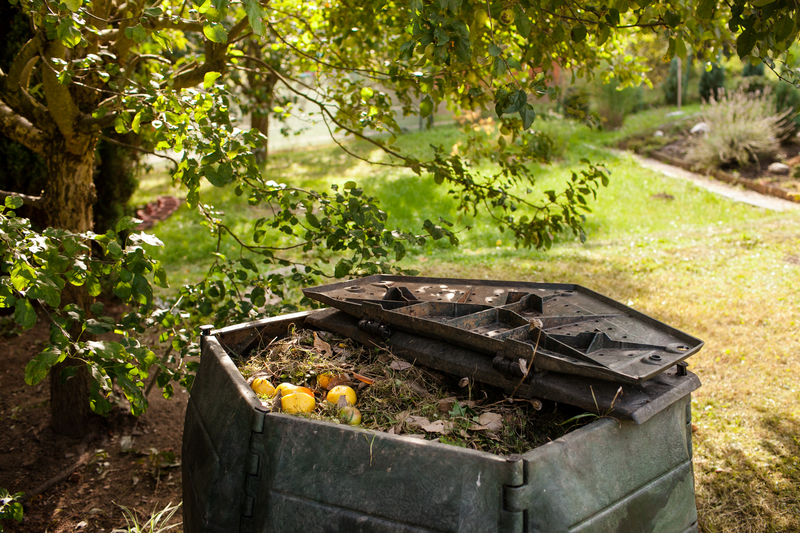Sustainable Kitchen Tips for Disposing and Recycling Pots and Pans
Are your old pots and pans piling up in your kitchen or garage? If you're passionate about sustainability, the way you dispose of or recycle cookware matters as much as what you cook! Discover eco-friendly kitchen tips for safely disposing and recycling your old pots and pans, and learn how to give cookware a new life instead of sending it to landfill. In this comprehensive guide, we'll cover everything from the importance of sustainable cookware disposal to creative strategies for reusing old kitchenware and where to find recycling programs near you.
Why Eco-Friendly Disposal of Pots and Pans Matters
Every year, millions of used or broken pots and pans end up in landfills, contributing to environmental damage. Disposing of cookware responsibly is crucial for several reasons:
- Reduces landfill waste: Metal and nonstick coatings can take decades or longer to degrade, polluting the planet.
- Recovers valuable materials: Metal, aluminum, and certain plastics can be recycled to produce new products, reducing demand for virgin resources.
- Lowers carbon footprint: Recycling cookware typically uses less energy and water than manufacturing from scratch.
- Supports the circular economy: When you reuse, repurpose, or recycle, you promote a sustainable consumer ecosystem.
Eco-conscious disposal is a simple but effective way to make your kitchen habits more sustainable!

Understanding Types of Cookware: What Can Be Recycled?
Not all cookware is created equal--materials, coatings, and handles affect recycling options. Here's a quick overview of common types of pots and pans and their sustainability:
- Stainless Steel: Highly recyclable and prized for scrap value.
- Cast Iron: Fully recyclable, but great for refurbishing or upcycling due to its durability.
- Aluminum: Widely accepted at metal recycling centers, provided they're uncoated.
- Copper: Valuable and highly sought after for recycling, though sometimes harder to find drop-off points.
- Non-Stick Coated (e.g., Teflon): Trickier, as coatings can contaminate recycling processes; often needs special handling.
- Enamel-Coated: Usually recyclable as scrap metal after handles are removed.
- Glass/Ceramic: Usually not accepted in curbside recycling, but can sometimes be dropped at special depots or reused.
- Plastic Handles: Not typically recyclable; may need removal before recycling the main pot or pan.
Always check with your local waste management or recycling center for their specific requirements before disposing of or recycling cookware.
How to Sustainably Dispose of Old Pots and Pans
Ready to handle your kitchen declutter sustainably? Here are tried-and-tested sustainable kitchen tips for disposing and recycling pots and pans:
1. Repurpose or Upcycle Your Old Cookware
Instead of tossing pots and pans in the bin, ask: Can this item find a new use? Upcycling and repurposing give cookware a second life and reduce waste.
- Planters: Drill holes in the bottom and turn old pots into unique garden planters.
- Storage bins: Use clean saucepans or skillets to organize kitchen tools, office supplies, or craft materials.
- Candle holders: Mini pans can make quirky candle containers for indoor or outdoor use.
- Wall art: Decorate and hang interesting pans or lids for vintage kitchen decor.
- Pet bowls: Sturdy, non-toxic pans are perfect for feeding pets.
2. Donate Gently Used Cookware
If your pots and pans are still functional (no major dents, holes, or peeling coatings), they can serve someone else. Consider:
- Charity shops and second-hand stores
- Local shelters, food banks, or housing charities
- College students setting up new apartments
- Community centers or churches
- Friends, family, or neighbors
Always clean and inspect cookware before donating. If non-stick pans are scratched or begin to peel, skip donation--damaged coatings may be unhealthy for use.
3. Sell or Trade Online
Platforms like Facebook Marketplace, Craigslist, and specialized secondhand websites are great for selling or trading usable pots and pans. This keeps products in circulation and extends their life.
- Create an engaging listing with clear photos and descriptions.
- Bundle sets to encourage faster sale or exchange.
- Highlight vintage or high-quality brands--collectors may be interested!
4. Recycle Cookware: Finding the Right Recycling Program
If your cookware is no longer usable, recycling is the most eco-friendly disposal method. Here's how to get started:
- Contact your local recycling center: Ask about their pots and pans recycling policy. Some only accept metals at certain drop-off locations.
- Look for scrap metal yards: These often accept steel, iron, aluminum, or copper cookware. Call ahead to confirm accepted materials.
- Mail-in recycling programs: Some national brands (GreenPan, Calphalon) or private companies offer mail-back programs for cookware recycling.
- Municipal bulky waste collection: Some towns accept metal items during scheduled pick-ups--check the guidelines for your area.
Hot tip: Remove plastic parts (like handles or lids) before recycling, unless your local program specifies otherwise. Clean the pans (no food residue!) to avoid contamination.
Dealing With Non-Stick and Specialty Coated Cookware
Disposing of non-stick, ceramic, or specialty coated pots and pans takes extra care. Here's what you should know:
- Non-stick pans (Teflon, PTFE, etc.): Most curbside or scrap yards do NOT accept these due to risks of toxic fumes when heated to high temps. Some manufacturers run take-back recycling schemes--contact the brand or search their website.
- Ceramic-coated cookware: If the base is metal, remove non-metallic parts and recycle as scrap metal. Pure ceramics usually can't be recycled in regular programs.
- Broken glass or Pyrex pans: Not accepted in normal glass recycling due to their heat resistance. Some cities have special drop-offs for oven-proof glass.
If you're unsure: Contact your local waste authority for guidance on disposing or recycling specialty cookware.
Step-By-Step Guide: How to Prepare Pots and Pans for Recycling
Ready to recycle your old pots and pans responsibly? Follow this checklist for best results:
-
Check the material:
- If it's mostly metal, it's likely recyclable as scrap.
- Plastic, wooden, or rubber handles may need removal first.
- Non-stick coatings may make recycling tricky--confirm with your recycler.
-
Clean thoroughly:
- Scrape out all food residues and scrub away grease.
- Wash and dry completely to prevent contamination.
-
Remove non-recyclable parts:
- Unscrew plastic, silicone, or wooden handles, knobs, and lids.
- Dispose of these components as general waste if not recyclable.
-
Take to recycling:
- Bring to a designated scrap metal recycling facility or recycling event.
- Follow posted instructions or ask staff for help on where to deposit cookware.
-
Log your sustainable effort!
- Many local governments and recycling centers track recycling metrics as part of sustainability programs--join in and help inspire your community.
Green Alternatives When Buying New Pots and Pans
Once you've decluttered, consider these sustainable kitchen tips for your next cookware purchase:
- Choose high-quality, long-lasting items: Durable stainless steel, cast iron, and ceramic can last a lifetime with proper care.
- Look for recycled materials: Brands like GreenPan and Revereware offer lines with recycled aluminum or steel content.
- Avoid toxic coatings: Opt for pans free from PFAS, PFOA, PTFE, or heavy metals.
- Buy second-hand: Consignment stores and thrift shops often have quality cookware at a fraction of the price and zero new materials used!
FAQs on Recycling and Disposing of Pots and Pans
1. Can frying pans go in the recycling bin?
No, most curbside recycling bins do not accept pots and pans due to size, weight, and coating issues. Take them to a scrapyard or special recycling facility instead.
2. What do I do with broken handles or lids?
Plastic, silicone, or glass parts are often not recyclable. Remove them from metal pans and dispose of as regular waste, unless your recycling center provides specific drop-off bins.
3. Are there cookware brands with recycling programs?
Yes, some manufacturers provide mail-back recycling or take-back drop-offs. Examples include Calphalon's recycling program and some initiatives through kitchenware retailers.
4. How can I tell if my old pan is safe to donate?
Check for intact surfaces (no peeling, warping, or rust inside), sturdy handles, and a lack of deep scratches or dents. If non-stick coating is damaged, do not donate.

Creative Ideas for Giving Old Kitchenware a New Life
Beyond recycling, get creative with your old pots and pans for a fun, sustainable kitchen experience. Try these ideas:
- Make a bird feeder: Hang an old skillet and fill it with seeds.
- Herb garden containers: Smaller pots make great windowsill herb planters.
- Craft a clock: Use a decorative old pan as a funky kitchen clock base.
- Holiday decorations: Paint lids and pans with festive designs for seasonal decor.
Remember: Sustainability isn't just about recycling--it's about rethinking resources and closing the loop in your kitchen.
Conclusion: Make Your Kitchen More Sustainable, One Pan at a Time
From recycling metal cookware to upcycling damaged pans into home decor, sustainable kitchen habits start with small, practical steps. Next time you declutter, think twice before throwing your old pots and pans in the trash. By donating, selling, or recycling--plus buying better when you need to--you help protect the planet and inspire a greener community. With these sustainable kitchen tips for disposing and recycling pots and pans, you're well on your way to a cleaner kitchen and a cleaner world!
Let your commitment to sustainability shine from your stovetop to your recycling bin!